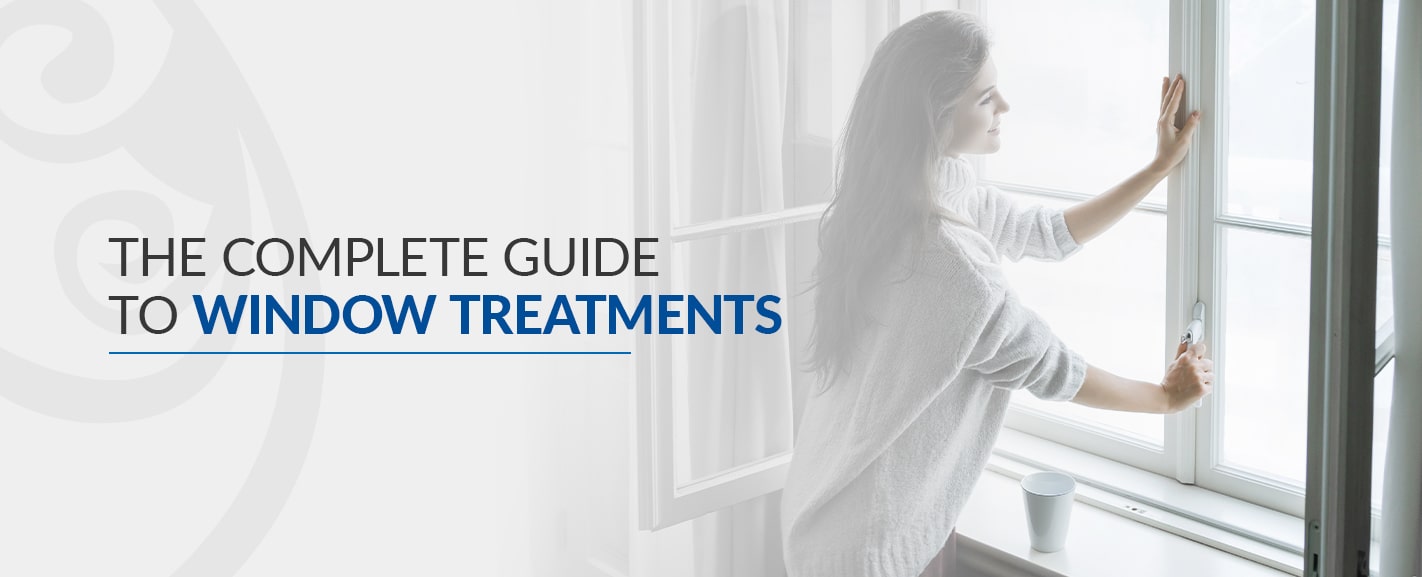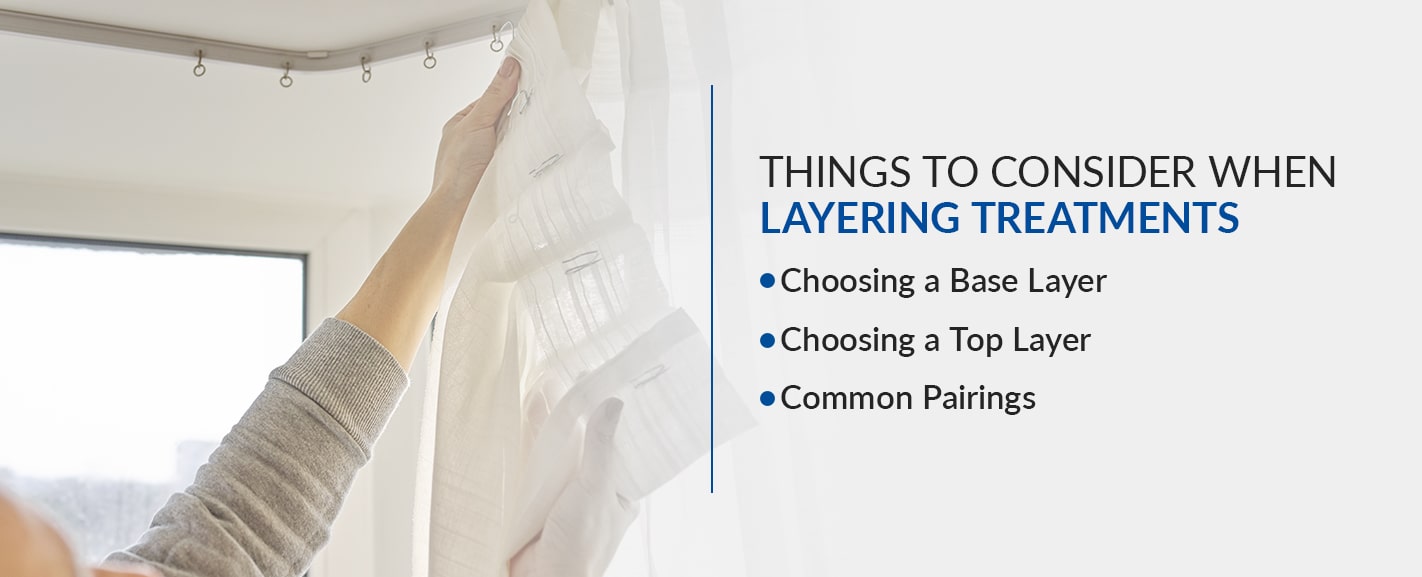The Complete Guide to Window Treatments
Table of Contents
- Things to Consider When Layering Treatments
- Window Treatment Do’s and Don’ts
- Learn More About Layering Window Treatments With Allure Window Treatment
Windows are the most visually interesting aspect of a room. You’re meant to look at — and through — your windows! They’re moving paintings that provide a glimpse of the outside.
No painting is ready for display without the right frame. Layering window treatments allows you to choose the perfect visual frame for your windows, enhance the design of your space, and provide a practical means of filtering natural light and creating privacy.
There’s no one-size-fits-all answer to how to layer window treatments. You’ll need to consider the existing design of the space, the fabrics and materials of your top and base layers, the color palette and accents you want to work with, and the accessories and hardware that hold it all together.
Things to Consider When Layering Treatments
When layering window treatments, you’ll need to consider many factors.
1. Choosing a Base Layer
Your base layer is the one closest to the window and acts as the primary method of regulating the amount of light and temperature that enters the windowed space through the window. The types of base layers include:
- Shutters: Shutters are a solid frame of louvers that can be adjustable or stationary. Shutters may be made from a variety of materials, including vinyl, fabric or even glass.
- Blinds: Blinds feature slats of material, often wood or faux wood, that can be raised or lowered manually with a cord. In some blinds, the angle at which these slats rest can be adjusted to allow varying degrees of light through the window.
- Shades: A window layer made of one continuous piece of fabric is called a shade. This solid construction means that you can only alter the degree of light coming in through a window by raising or lowering shades, unlike blinds.
- Sliding panels: An easy way to think of these is like blinds turned on their side. Sliding panels are stretches of fabric attached to frames that move horizontally along a window. They often come in pairs and meet in the center of the window to cover it completely. Occasionally, some sliding panels run on perpendicular tracks in multiple layers to create a shuttered visual effect.
2. Choosing a Top Layer
Your top layer is the one that’s closest to the interior of the room. It’s the last component to be exposed to light coming from sources outside your window,
- Curtains: Curtains are lighter-weight fabric panels that are on the more translucent side of the opacity scale. Curtains occasionally cover a window when fully drawn though some may be short enough to allow light in from the bottom.
- Draperies: Draperies are heavier-weight fabric panels that may have additional material sewn on their inside to block light and retain heat. They are most often on the opaque side of the opacity scale.
- Valances: A valance is a short decorative curtain that runs along the top of a window and does not cover it completely.
- Cornices: A cornice is a hard treatment layer used at the top of a window to cover up the hardware—such as the curtain rod and blind box. Cornices can be made of various hard materials or may feature fabric upholstered onto a board to give it a rigid structure.
3. Common Pairings
There are many options to choose from when deciding on window treatment layers. However, there are a few combinations of top and base layers that you might frequently see, such as:
- Drapes layered over blinds.
- Curtains layered over shades.
- Shutters drawn underneath curtains.
- Blinds covered by cornices.
- Curtains topped by a valance.
These are just some of the more common variations you might see when exploring window layer treatment options. Designers often consider layering additional treatments between these top and base layers to allow for more unique designs.
Window Treatment Do’s and Don’ts
Here are some tips for how to layer curtains or other window treatments to achieve the most cohesive, attractive effect.
Don’t Forget About Function
If the sun’s getting directly in your guests’ eyes every time they look in the direction of your window, they likely won’t appreciate the beautiful prints you’ve chosen. Starting with your functional considerations first is key to good window layering.
Beyond light, temperature control is another critical function. If you’re dressing windows in a room that receives direct sunlight all day, the degree to which your base and top layers can regulate temperature is essential.
Do Consider the Space
Layering curtains and blinds should be part of a bigger design strategy that complements the existing appearance of your room. When you consider the existing color palette, prints and patterns of the room, you can find opportunities to choose window treatments that accent or contrast those features to give your windows the pizazz they deserve.
Don’t Ignore the Impact of Lighting
Take time to think about the sources of light that will interact with your window layering. Ask yourself questions like:
- Does your window face a busy street?
- Are you looking out from a window several stories above the city skyline?
- Does your window face the sunrise or sunset?
- What’s the lighting situation inside the room?
Different materials and fabrics feature different degrees of opacity and diffuse light in different ways. When pairing curtains with blinds or another base layer, you’ll need to consider the appearance of your choices with the light they’ll receive throughout the day and evening.
Do Create Visual Contrast and Accents in the Right Places
If you’re taking the time to implement different layers to your windows, you should also take the time to make them visually distinct. If you choose one print for your base layer, try a solid color for your top layer. Choosing two different prints for each layer will create too much visual noise for your design.
Often, designers will implement hard window treatments with soft window treatments to create another contrast beyond color, texture and design.
If you’re working with a third layer of window treatment, such as a valance, you might consider a fabric color complementary to the one you’ve picked out for your top layer. This can really provide a pop to a window without distracting too much from the rest of your room!
Another fun opportunity for visual contrast and accent is looking at the hardware that holds up your treatments. When you can match the brass curtain rod with some brass tiebacks, you help reinforce the rest of your window treatment design.
Learn More About Layering Window Treatments With Allure Window Treatments
If you’re looking to find the perfect layered window treatment for your space, our designers are here to help your vision come to life. We’ve been the leader in window treatment design since we opened our Philadelphia studio in 2007. Our design, installation and workroom teams are ready to collaborate and provide your home or commercial space the window treatments to bring it to life.
Contact us to learn more about layering window treatments with Allure Window Treatments and schedule your free consultation today.[/vc_column_text][/vc_column][/vc_row]

Shani is the Marketing Director of Allure Window Treatments. She has over a decade of experience in the home improvement and window treatments industry.



Sorry, the comment form is closed at this time.